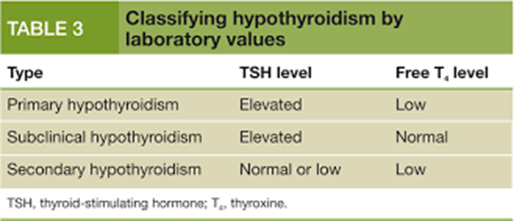A nurse in a clinic is reviewing the laboratory values of a client who has primary hypothyroidism.
Which of the following laboratory values should the nurse anticipate an elevation of?
Free T4
Serum T3
Serum T4
Thyroid stimulating hormone (TSH)
The Correct Answer is D
A. In primary hypothyroidism, the thyroid gland fails to produce sufficient thyroid hormone.
Consequently, free T4 levels are typically decreased.
B. Although serum T3 levels may also decrease in primary hypothyroidism due to impaired thyroid function, TSH is the primary marker used for diagnosis and monitoring.
C. Similarly, serum T4 levels may decrease in primary hypothyroidism due to decreased synthesis by the thyroid gland.
D. In primary hypothyroidism, the anterior pituitary gland releases more TSH to stimulate the thyroid gland to produce thyroid hormones. Therefore, elevated TSH levels are characteristic of primary hypothyroidism.

Nursing Test Bank
Naxlex Comprehensive Predictor Exams
Related Questions
Correct Answer is B
Explanation
A. Muscle hypertrophy is not a typical manifestation of hypercortisolism; rather, muscle weakness and wasting may occur.
B. Moon face, or rounded facial appearance with prominent cheeks, is a characteristic manifestation of hypercortisolism (Cushing's syndrome).
C. A butterfly rash on the face is not specific to hypercortisolism; it may suggest other conditions such as systemic lupus erythematosus.
D. Chvostek's sign is associated with hypocalcemia, not hypercortisolism.
Correct Answer is A
Explanation
A. Sudden weight gain is a common sign of fluid overload in clients with end-stage kidney disease undergoing hemodialysis.
B. Skin turgor assessment is not as reliable in individuals with kidney disease due to changes in skin elasticity.
C. Flattened neck veins are not indicative of fluid overload; rather, they suggest dehydration.
D. Oxygen saturation may be affected by various factors but is not directly related to fluid overload in this context.
Whether you are a student looking to ace your exams or a practicing nurse seeking to enhance your expertise , our nursing education contents will empower you with the confidence and competence to make a difference in the lives of patients and become a respected leader in the healthcare field.
Visit Naxlex, invest in your future and unlock endless possibilities with our unparalleled nursing education contents today
Report Wrong Answer on the Current Question
Do you disagree with the answer? If yes, what is your expected answer? Explain.
Kindly be descriptive with the issue you are facing.
